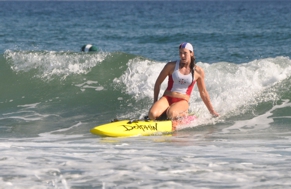National Lifeguard certification is Canada's professional
lifeguard standard and is designed for lifesavers who wish to
obtain a responsible job and leadership experience. Successful
candidates are certified by the Lifesaving Society - Canada's
lifeguarding experts.
National Lifeguard - Surf certification is
designed to develop the lifeguarding skills, principles and
practices, and the decision-making processes which will assist the
lifeguard to provide effective safety supervision of surf beach
environments. It builds on the fundamental values, judgment,
knowledge, skills and fitness developed in the National Lifeguard
Waterfront certification.
Prerequisites: National Lifeguard - Waterfront
certification.
Required reference material:
Alert.
:::

Instruction and certification: Current National
Lifeguard Instructors teach and evaluate most items, but only
National Lifeguard Examiners may certify candidates. The Lifesaving
Society deems its certifications to be "current" for 24 months from
the certification date.
Candidate recognition: National Lifeugard
crest, certification card.
At-A-glance
Test Items
- *Surf beach analysis: Demonstrate an
understanding of:
- Features that vary from surf beach to surf beach (or from time
to time) and how analysis of these affects lifeguarding
- Environmental hazards of a surf beach
- *Entries and removals: Demonstrate a variety
of entries with a rescue aid and a variety of removals appropriate
to a surf environment
- *Skin diving skills: Demonstrate skin diving
skills: Wearing mask, fins and snorkel, swim 5 metres at the
surface; head-first surface dive and swim 15 metres underwater;
surface, purge snorkel and swim 5 metres at the surface.
- *† Use of rescue craft: D: Demonstrate
effective use of a rescue board or rescue craft: Approach 5 metres
on the beach; enter the water with a rescue craft; pick up a victim
100 metres away and return to shore.
- Physical standards
- *Run swim run: Demonstrate aerobic fitness:
Run 200 metres; swim 200 metres; run 200 metres - all within 8
minutes
- *† Endurance challenge: Demonstrate aerobic
fitness and endurance: Swim 400 metres within 10 minutes.
- *Lifeguard communication: Demonstrate
effective communication with patrons, victims, other lifeguards,
supervisors and emergency service personnel.
- Supervision
- *Position and rotation: Demonstrate effective
pool supervision using lifeguard positioning and rotation.
- *† Scanning and observation: Demonstrate
effective lifeguard scanning techniques and observation skills in
the pool environment.
- *Prevention and intervention: Demonstrate an
ability to recognize situations in which early lifeguard
intervention may prevent a rescue emergency.
- :::
- *Missing person: Demonstrate an effective
search of the aquatic facility for a missing person as both a
member and a leader of a lifeguard team.
- Victim management
- *† Management of distressed or drowning
victim: Demonstrate effective management of a distressed
or drowning victim in deep water: Run 100 metres with a rescue aid;
enter water and swim 100 metres to recover a conscious victim; tow
or carry the victim 100 m; provide appropriate follow-up
treatment.
- *† Management of submerged, non-breathing
victim: Demonstrate effective management of a submerged,
non-breathing victim and perform 10 cycles of 2 ventilations:30
compressions on a CPR manikin.
- *Management of spinal injured victims: With
the assistance of one back-up lifeguard or assistant lifeguard and
one bystander, demonstrate effective management of suspected
spinal-injured victims (breathing and non-breathing) found in the
water
- *† Management of an injured victim:
Demonstrate effective management of an injured victim on land or in
the water.
- † Lifeguard team situations: As a member of a
lifeguard team, respond to situations in a supervised aquatic
setting.
- *Asterisk indicates instructor-evaluated item. The † symbol
denotes the only items evaluated during a recertification.